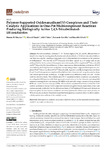Mostrar o rexistro simple do ítem
Polymer-Supported Oxidovanadium(IV) Complexes and Their Catalytic Applications in One-Pot Multicomponent Reactions Producing Biologically Active 2,4,5-Trisubstituted-1H-imidazoles
| dc.contributor.author | Maurya, Mannar | |
| dc.contributor.author | Nandi, Monojit | |
| dc.contributor.author | Patter, Akhil | |
| dc.contributor.author | Avecilla, Fernando | |
| dc.contributor.author | Ghosh, Kaushik | |
| dc.date.accessioned | 2023-06-26T14:49:25Z | |
| dc.date.available | 2023-06-26T14:49:25Z | |
| dc.date.issued | 2023-03-19 | |
| dc.identifier.citation | Maurya, M.R.; Nandi, M.; Patter, A.; Avecilla, F.; Ghosh, K. Polymer-Supported Oxidovanadium(IV) Complexes and Their Catalytic Applications in One-Pot Multicomponent Reactions Producing Biologically Active 2,4,5-Trisubstituted-1H-imidazoles. Catalysts 2023, 13, 615. https://doi.org/10.3390/catal13030615 | es_ES |
| dc.identifier.issn | 2073-4344 | |
| dc.identifier.uri | http://hdl.handle.net/2183/33246 | |
| dc.description | This article belongs to the Special Issue Multicomponent Catalytic Reactions under Green Conditions | es_ES |
| dc.description.abstract | [Abstract] Two new monobasic tridentate O⁀N⁀N donor ligands, HL1 (I) and HL2 (II) have been obtained in two steps by reacting phenylhydrazine and salicylaldehyde or 3,5-di-tert-butylsalicylaldehyde and then reacting the resulting compounds with 2-chloromethylbenzimidazole in the presence of triethylamine. The reaction of [VIVO(acac)2] with these ligands in a 1:1 molar ratio in dry methanol led to the formation of homogeneous oxidovanadium(IV) complexes [VIVO(acac)L1] (1) and [VIVO(acac)L2] (2). Immobilization of these complexes on chloromethylated polystyrene (PS-Cl) cross-linked with divinyl benzene resulted in corresponding polymer-supported heterogeneous complexes PS-[VIVO(acac)L1] (3) and PS-[VIVO(acac)L2] (4). Ligands (I and II), homogeneous complexes (1 and 2) and heterogeneous complexes (3 and 4) have been characterized using elemental analysis and various spectroscopic techniques. A single crystal X-ray diffraction study of I and 1 further confirms their structures. The oxidation state IV of vanadium in these complexes was assured by recording their EPR spectra while heterogeneous complexes were further characterized using field emission-scanning electron microscopy (FE-SEM) combined with energy dispersive X-ray analysis (EDS) and atomic force microscopy (AFM). All vanadium complexes have been explored for their catalytic potential to one-pot-three-component reactions (reagents: benzil, ammonium acetate and various aromatic aldehydes) for the efficient synthesis of 2,4,5-triphenyl-1H-imidazole derivatives (nine examples). Various reaction conditions have been optimized to obtain a maximum yield (up to 96%) of catalytic products. It has been found that heterogeneous complexes show excellent catalytic activity and are recyclable up to five catalytic cycles. | es_ES |
| dc.description.sponsorship | This research was funded by the Science and Engineering Research Council (CRG/2018/000182), the Department of Science and Technology, New Delhi, the Government of India | es_ES |
| dc.description.sponsorship | India. Science and Engineering Research Council; CRG/2018/000182 | es_ES |
| dc.language.iso | eng | es_ES |
| dc.publisher | MDPI | es_ES |
| dc.relation.uri | https://doi.org/10.3390/catal13030615 | es_ES |
| dc.rights | Atribución 4.0 Internacional | es_ES |
| dc.rights.uri | http://creativecommons.org/licenses/by/4.0/ | * |
| dc.subject | Heterogeneous catalysts | es_ES |
| dc.subject | Vanadium complexes | es_ES |
| dc.subject | One pot multicomponent reaction | es_ES |
| dc.subject | Single crystal X-ray study | es_ES |
| dc.subject | Spectroscopy | es_ES |
| dc.title | Polymer-Supported Oxidovanadium(IV) Complexes and Their Catalytic Applications in One-Pot Multicomponent Reactions Producing Biologically Active 2,4,5-Trisubstituted-1H-imidazoles | es_ES |
| dc.type | info:eu-repo/semantics/article | es_ES |
| dc.rights.access | info:eu-repo/semantics/openAccess | es_ES |
| UDC.journalTitle | Catalysts | es_ES |
| UDC.volume | 13 (2023) | es_ES |
| UDC.issue | 3 | es_ES |
| UDC.startPage | 615 | es_ES |
| dc.identifier.doi | 10.3390/catal13030615 |






